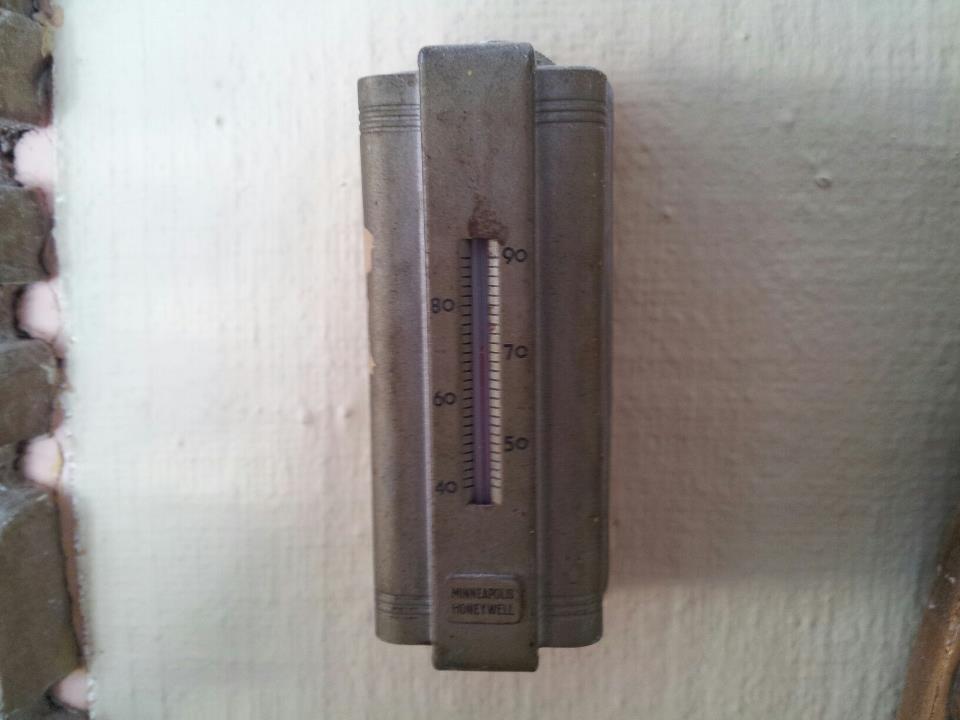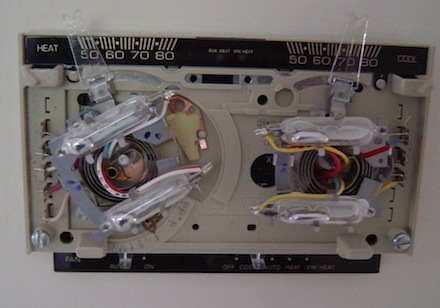The Mad Hatter, Isaac Newton, and That Old Thermostat

I was a kid a long, long time ago. Seems like it was another century…another millennium even. Wait a minute — it was another millennium! That was back in the day when we used to ride bicycles without helmets, apply mercury to our wounds, move seat belts out of the way (if the car even had them), and put our tongue on steel poles in the middle of winter. Of course, in Texas and Louisiana we just ended up with a bad taste in our mouth from those steel poles and wondered why people made such a big deal about it.
It was so long ago that our grandparents had stuff in their houses that you’ve probably never even heard of. I loved going to Mammaw and Pappaw’s house because they had all kinds of cool, old stuff. Even better, Pappaw had a warehouse full of even older, old stuff and a shop for his business (Bailes Electric Co.) that had the most enticing stuff ever.
For example, he had voltmeter probes hanging down right next to an electrical outlet. Of course, I had to stick them in there. I don’t know how it happened, but my recollection is that I made sparks…and got in trouble. And then there was that fascinating lamp way up on the top shelf. It had a blue bulb, so I just had to plug it in and see how beautiful the light was. Got sparks that time, too. Old stuff is really cool!
 Take that thermostat you see above. It’s from 1941. Back then, nobody had any of this newfangled digital stuff with thermistors and integrated circuits. No, it was mechanical, and it worked. Random cosmic rays zipping through the device never threw things off, making you have to reboot the system. If it didn’t work, you could take the cover off, find out what was wrong, and fix it. Now, if some piece of digital equipment doesn’t work, a technician replaces the innards—or the whole thing. There’s not much fixin’ anymore.
Take that thermostat you see above. It’s from 1941. Back then, nobody had any of this newfangled digital stuff with thermistors and integrated circuits. No, it was mechanical, and it worked. Random cosmic rays zipping through the device never threw things off, making you have to reboot the system. If it didn’t work, you could take the cover off, find out what was wrong, and fix it. Now, if some piece of digital equipment doesn’t work, a technician replaces the innards—or the whole thing. There’s not much fixin’ anymore.
My friend Guy Theriot posted the photo of that old thermostat above on Facebook yesterday. Guy and I go way back. Although he lives in Minnesota now, he’s a Cajun. He was a friend of mine down the bayou in Chauvin, Louisiana, and we hung out together a lot in my first few years with the Cajuns.
About those old thermostats…
The old thermostats, as I said above, operated on mechanical principles. In the thermostat shown below, a bimetallic strip expanded or contracted with temperature because of the different thermal expansion coefficients of the two metals. That strip was connected to vials of mercury. The vials tilted as the bimetallic stip changed size, and the mercury would either complete the circuit or cause the circuit to be open. The thermostat below has 2 bimetallic strips and 4 vials of mercury – two separate mechanisms for heating and cooling.

When the mercury went one way in the vial, electricity flowed and the heating or cooling system came on. When it went the other way, the electricity didn’t flow and the HVAC system was off. Simple and elegant! That’s how we rolled back then.

The downside of that simplicity and elegance was rivers on fire, smog that burned your eyes, and kids who weren’t wearing seatbelts getting thrown out of cars. Buddy Meyer was a friend of mine and Guy’s. The last time I saw him was the summer of ’73, right before my dad took me and my sisters to Leesville for two months. I remember Buddy, Guy, and I were riding our bicycles one day. Two months later, I arrived back in Chauvin and heard from my mom that Buddy was dead, thrown from his uncle’s truck when they crashed. We didn’t wear seat belts then.
Mad as a hatter
Back to those old thermostats now, the mercury they contain is a toxic material. When I was kid back in the last millennium, we’d put it on our scraped knees. It was red and it stung like the dickens. (I’ve never been stung by a dickens, or even seen one, but I imagine it as a wasp about the size of a coyote with fierce looking, bloodshot eyes and a huge, poisonous stinger.) It came in little brown bottles with a screw top that had a built-in eyedropper. Mammaw called it mercurochrome. Now it’s banned by the FDA.
 Mercury, as it turns out, is pretty darn toxic. Dartmouth chemistry professor Karen Wetterhahn found out the hard way. She was working with dimethylmercury, one of the most toxic mercury compounds, and accidentally got some on her gloves. It went through, got into her blood, and she was dead in a year.
Mercury, as it turns out, is pretty darn toxic. Dartmouth chemistry professor Karen Wetterhahn found out the hard way. She was working with dimethylmercury, one of the most toxic mercury compounds, and accidentally got some on her gloves. It went through, got into her blood, and she was dead in a year.
Isaac Newton, known to have had a nasty dispostion and a bit of paranoia at one point in his life, is also believed to have suffered from mercury poisoning. Around the time he was doing experiments with mercury, he “accused friends of plotting against him, slept little, and reported conversations that did not exist.”
And then there was Alice’s friend, the Mad Hatter. He wasn’t the only hatter who had mental challenges. Evidently it was common because of the mercury they used when felting the hats they made. The expression ‘mad as a hatter‘ may have its origin in mercury poisoning.
Mercury and energy
Old thermostats aren’t the only place you find mercury in the world of energy production and consumption. It’s also in fluorescent lights, both the straight tube and the compact fluorescent lamp (CFL) forms. Both should be disposed of properly. Compared to thermostats, though, they contain only a small amount of mercury.
The largest single source of mercury is burning coal to produce electricity. “Coal-burning power plants are the largest human-caused source of mercury emissions to the air in the United States, accounting for over 50 percent of all domestic human-caused mercury emissions,” according to the US EPA.
The moral of the story is that when old timers like me say that we were so much tougher back in the day, be sure to keep it all in perspective. Yeah, some things were better, but in other respects, we’re better off now. Mercury’s not something to mess around with. If you’ve got an old thermostat or dead fluorescent lamps, don’t just throw them in the trash.
Allison A. Bailes III, PhD is a speaker, writer, building science consultant, and the founder of Energy Vanguard in Decatur, Georgia. He has a doctorate in physics and is the author of a bestselling book on building science. He also writes the Energy Vanguard Blog. For more updates, you can follow Allison on LinkedIn and subscribe to Energy Vanguard’s weekly newsletter and YouTube channel.
Related Articles
I Really Want to Try the Nest Thermostat
If You Think Thermostat Setbacks Don’t Save Energy, You’re Wrong!
Cajuns, Living Down the Bayou, and Peak Oil
Not All Knowledge Comes from College
Photo credit: Top photo of 1941 Honeywell thermostat courtesy of Guy Theriot of Eagan, Minnesota. Middle three photos from Allison Bailes/Energy Vanguard. Mad Hatter photo from Wikimedia Commons.
This Post Has 14 Comments
Comments are closed.

Wish I had read this
Wish I had read this after my ribs stopped aching from last weeks bout with the flu. Informative and amusing. Can’t beat that combination.
Anyone looking for mercury will find tons of it in sediment at the bottom of the Carson River, where it accumulated following the days of the Comstock Lode and where the EPA decided it would be best left…unmolested.
Ah, the good old days. They don’t build’em like they used to.
Makes one wonder what future generations (who have never done anything for us, btw) will find to scoff and roll their eyes at in days to come?
Thanks for the article, Allison!
mercurochrome sure worked if
mercurochrome sure worked if the intended purpose was to cause discomfort and make us talk to ourselves in older age! I am still impressed with the Apple device on the wall which you showed me could be programed from a phone when away from the home. Great article, again! Keep fightin the good fight!
Edison lamp lovers have been
Edison lamp lovers have been pushing the mercury in CFL as a way to keep the Edison lamp alive. They never mention that the old thermostats contain enough mercury to make about 100 CFL lamps. Yet no hazmat crew has ever been dispatched over a broken thermostat…
Allison,
Allison,
Your article reminded me of a great many similar things, as you and I are about the same age.
Like riding our bikes without helmets. It wasn’t even a thought. And “play dates” back then were basically day-long adventures on our bikes. I’m surprised we survived much of the crazy stuff we got into on those excursions.
And seat belts: Our “lap belts” were always jammed way down between the cushions and backrests to keep them out of the way. When my mom got a new 1970 Dodge Swinger, it had these innovative “shoulder harness” belts, which we kids thought were cool, because they were like something an astronaut would wear, but still, they were never used.
A great irony of all this is that, as far back as the 1930s, auto makers had already concluded, using motion picture cameras and test dummies, that people often were seriously injured, even in relatively low speed collisions, because they were getting impaled on projecting dash board controls. Yet nearly forty years later, no one was wearing seat belts, and dash boards were still jagged landscapes.
My conclusion is that we human beings are are only partly rational creatures, and often will take a very long time to finally admit to something plainly obvious, or experimentally proven, especially when it’s contrary to cherished or ingrained belief (i.e., back when I was a kid, many folks considered a plastic dashboard Jesus absolutely essential, while the use of seat belts was considered totally unnecessary, unwelcome, uncool, or even down right communistic).
At least we’re starting to get better at many things, and seem to be gradually overcoming these strange, irrational patterns of thought. But sensible change still seems to move at a pretty slow pace.
~ John
Allison
Allison
Pretty good reminiscing for a kid 😉
I remember a teacher passing a glob (Technical term) of mercury around so we could try to hold it in our hands. I presume that school building is still contaminated.
One thing you could do with those bi-metal t’stats was mount them on a slight angle to control heat in low temp areas. I don’t think the Nest has that capability.
Great read. The mercury
Great read. The mercury fallout from fluorescent lights is probably bigger than we think because I don’t think most people dispose of spent bulbs properly and there are quite a lot of them out there. I live in New York City, and we produce a lot of trash. The other night, waiting for a friend to come downstairs, I sat in my car in a midtown commercial district watching a garbage crew collecting the trash. I wait for my friend often and have a lot of opportunity to marvel at how hard these guys work every night. But this time I watched in horror as one of them pitched one-by-one, spear-like, a box full of fluorescent tubes into the back of the garbage truck. As each one exploded, a sizable cloud rose and drifted out. I imagine this happens a lot, with all the commercial offices in midtown, and it freaked me out a lot: New York is famous not only for trash, but also for dust. Weekly you can wipe a rag along the window sills and it comes up black. Now I have new insight into the substance of all that black fallout. Scary, no?
I remember (mid 1970s)
I remember (mid 1970s) floating spent fluorescent tubes out into the harbor and (imagining them as German U-boats) “shelling” them with railroad tie bedding gravel (We also considered the active commuter rail line a perfectly good pedestrian and bike path – excellent at-grade shortcuts through the hilly town)
A hit on the center of a “U boat” would break it in two, and the metal ends would sink, tilting the jagged glass upward for two more targets of opportunity.
I ate plenty of flounder, a cherished native delicacy, caught in that harbor.
Allison, your writing is
Allison, your writing is STILL getting better! Another great post!
@ John Poole As noted in the
@ John Poole As noted in the book of the same name we are “Predictably Irrational” — Great Book
Allison -What year do you think the above thermostat was from? How about an oldest thermostat contest?
Great read. I found a twin to
Great read. I found a twin to that thermostat in a house this week.
In my business I often hear people make the comment; “They don’t build house’s like they used to”. Like you say, thank goodness for that. Lead paint, asbestos laced plaster, flooring and insulation, minimal to no insulation…
While some things may have been better back in the day, it’s just as likely nostalgia as it is fact.
Allison –The Thermostat I
Allison –The Thermostat I have in my desk was made by Minneapolis Honeywell Regulator Company utilizing a patent 1282546 granted on October 22, 1918. So it is newer than 1918. How old is yours?
The old one shown in the
The old one shown in the article above is from 1941, John. At least that’s what my friend who sent me the photo said. Another friend in the NYC area identified it as a model T11A and sent me this link to an old heating guidebook from Honeywell where they show it and others.
it is very nice
it is very nice
Regarding mercury, the malady
Regarding mercury, the malady lingers on.
Searched in vain for a recent article on high levels of mercury continuing to appear in California drainage. Conventional wisdom believed mercury was best left alone, as in the Carson River here in Northern Nevada. Unfortunately, the element is not cooperating.
Here’s a document from 2000 that lays out the situation:
http://pubs.usgs.gov/fs/2000/fs06100/pdf/fs06100.pdf
Best wishes